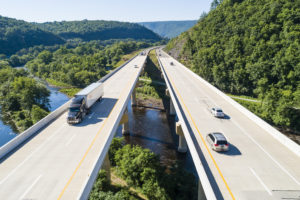Moving freight is challenging, especially when the load is very tall, wide, or heavy. Considered oversize, these loads require special handling and are subject to a variety of federal, state and local rules. As a result, shippers cannot simply load up a flatbed and head out down the road. Understanding what constitutes an oversize load, the permit process, and special considerations gives shippers the ability to deliver any load, regardless of size.
What Is An Oversize Load?
Oversize loads are defined as loads that exceed 80,000 pounds gross vehicle weight, 20,000 pound single axle weight and/or 34,000 pound tandem axle weight, according to federal law. Weight, however, is only part of the equation. Oversize can also refer to the width of the load, which is a maximum width of 120 inches. Although federal law does not specify limits on the height of a given load, state laws generally stipulate that loads cannot exceed 13′ 6” without a permit. What’s more, each state may also have additional weight restrictions for certain roadways and bridges. The reason for these restrictions is to protect the roadways and other infrastructure from sustaining damage.
How Do I Get a Permit for an Oversize Load?
Despite the fact that the federal government specifies the weight and width limits for commercial vehicles hauling loads, it does not issue permits. Oversize load permits must be obtained from the individual states prior to crossing the border. In some cases, individual counties and cities within a state require additional permits. Failure to obtain the proper authorizations will result in delays, additional fees and potential fines. None of these things are beneficial to the shipper or the receiver of the load. Therefore, it is imperative that shippers of oversize loads obtain the appropriate permits before shipping takes place.
How Do I Plan for an Oversize Load?
Routing is perhaps one of the most important things when it comes to oversize loads. Choosing a route that can withstand the weight of a heavy load, for example, reduces the possibility of doing damage. In addition, some loads may require the use of pilot cars, high pole cars or even police escorts. In some cases, it may be necessary for utility companies to move power lines, traffic lights or other obstructions that could hinder progress. Planning ahead for these things helps to assure that the load is delivered safely and that it arrives at its destination on time and in good condition.
If you’re preparing to ship a load that is deemed oversize, contact us. We’re experienced oversize load transporters and have delivered thousands of loads over the last two decades. We guarantee that all the proper permits will be obtained and that your shipment will arrive on time and in perfect condition.




